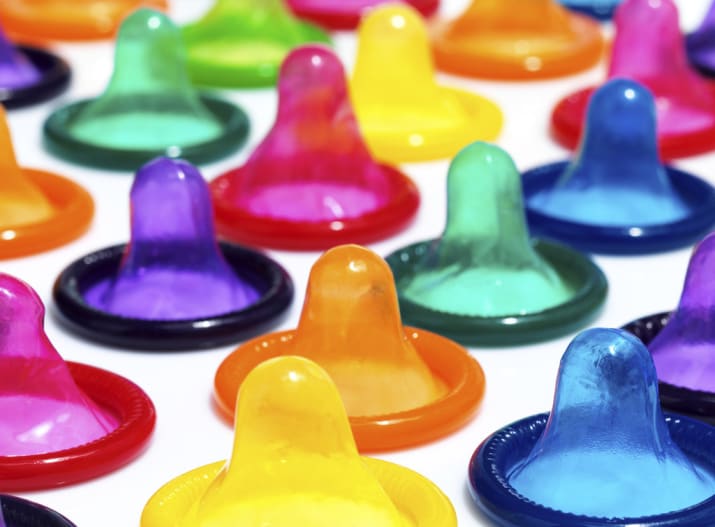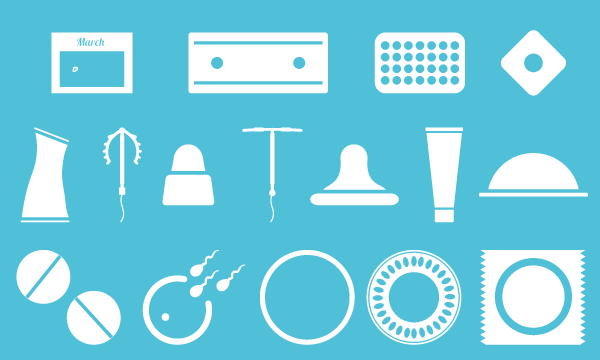Many birth control methods protect you against sexually transmitted infections and prevent unplanned pregnancies. One of the most common—and fairly inexpensive—among these methods is the male (traditional) condom. The lovely thing about condoms is the fact that they come in so many shapes, sizes, colors, textures, and lubrication all to provide comfort and pleasure. Most condoms are made out of latex, but for those who are allergic to latex, polyurethane condoms are suitable alternatives.
With such a large variety of condoms to choose from, how are you supposed to decide which one is best for you? For one, condom lubrication can vary. Most condoms come already lubricated with either a water-based or silicone-based substance, but unlubricated condoms are available as well. Condom lubrication can provide more comfort, prevent a condom from breaking, and make a condom easier to put on. It is not recommended to use oil-based lubricants with a latex condom, which can result in the condom breaking, since oil-based lubricants degrade latex. Examples of oil-based lubricants include baby oil and Vaseline (petroleum jelly). However, oil-based lubricants can be used with a polyurethane condom.
Condoms also come in a wide range of shapes, sizes, lengths, and widths. Picking the right one is mostly about personal preference. Brands offer different shapes to provide more comfort and pleasure; the texture of condoms may vary as well from studded to ribbed. Remember that condoms come in a variety of sizes to provide a good fit. A condom shouldn’t be too large because it can slip off during intercourse, which defeats the purpose of having a condom in the first place, as in such a case, you would be left with possible exposures to STIs and increased chances of pregnancy. There are also condoms that have smaller widths to provide a tighter or a “closer” fit. Different colors are sometimes available, but they typically have little impact on your experience. Flavored condoms, on the other hand, are designed to be used mostly for oral sex.
A condom should be put on once the penis becomes erect but before coming into contact with a partner’s vagina or anus. A new condom should be worn every time you decide to have intercourse. Condoms should never be reused! It is also best to change a condom when switching between modes of intercourse, like when going from vaginal to oral intercourse or vice versa. Below are the steps involved.
- First, inspect the condom packet to ensure it is in good condition (not torn or punctured). Be sure to note the expiration date to make sure that the date has not passed. Carefully open the packet at the corner without using your teeth or being too rough, as this could damage the condom.
- Second, place the condom over the erect penis with the tip facing away from you. Pinch the tip and roll the rest down to the base of the penis. Be sure to leave some room at the tip for semen to collect.
- After rolling down the condom, smooth out any air bubbles between the penis and the condom that can cause a condom to break. Extra lubrication can be added to the outside of the condom.
- After intercourse and/or ejaculation, withdraw the penis before it softens, carefully holding the condom against the base of the penis to prevent semen from spilling. Discard the condom in the trash.
When you’re going through these steps, take care not to make these following mistakes:
- Not storing the condom properly: It’s best to store a condom according to the manufacturer’s recommendations. Most condoms should not be left in extreme heat or light. For example, it’s not recommended to use a condom that has been stuck in your car on a hot day or one that has been sitting in your wallet, since either can cause damage to the packaging and the condom itself.
- Not inspecting the condition of the condom before use: This can cause you to use a defective or damaged condom, which can lead to the condom tearing and will not provide adequate protection.
- Putting on a condom too late (like halfway through intercourse) or taking it off too soon: For a condom to protect you against STIs or prevent pregnancy, it must be worn from start to finish. If a condom is put on halfway through intercourse, it is possible that you will have already come into contact with your partner’s fluids, which can allow for exposure to STIs. Similarly, taking a condom off partway through intercourse can also leave you exposed to STIs and at risk of an unplanned pregnancy if fluids (such as pre-cum coming into contact with the vagina) are exchanged.
- Reversing an unrolled condom: If a condom does not unroll easily, it may be inside-out (meaning the tip is pointing towards the penis and not away). When this happens, do not use the same condom because STIs or unintended pregnancies may result. Instead, grab a new condom and try again.
- Not leaving space at the tip for semen collection: Not leaving space for semen collection can result in condom leakage or rupturing. Spilled semen can lead to STIs or unplanned pregnancies.
Article by Marilyn Cabrera
Feature Image Source: BuzzFeed
























